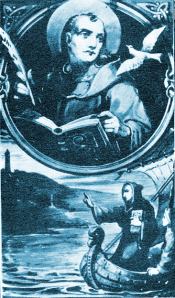Lives of the Saints
Our Models and Protectors
Spiritual Bouquet:
June 9

Saint Columba
or Columkille
Abbot
(521-597)
Saint Columba, the apostle of the Picts of Scotland, was born of a noble family in the county of Tyrconnel in Ireland, in 521. He studied Holy Scripture under the saintly bishop Finian, and when ordained a priest in 546 he opened a school where he formed several disciples. He founded several monasteries in Ireland. He is sometimes called Columkille, which is Old Irish for Founder of cells. Though austere, he was not morose; and, although he often longed to die, he was untiring in good works throughout his life.
His zeal in preaching against public vices offended King Dermot, and the Saint decided to leave his domains, departing for Scotland with a dozen of his disciples. He arrived there in 565, according to Saint Bede. There he founded a hundred religious houses and converted the Picts of the north, who in gratitude gave him the island of Iona, a short distance from the mainland. On that island Saint Columba founded his celebrated large monastery of Hy (or Y Colm-Kille), a school for apostolic missionaries and martyrs, and for centuries the last resting place of a multitude of Saints and of the kings of Scotland. Later its monks adopted the Rule of Saint Benedict.
The gentleness and charity of Saint Columba, which were unfailing, won the hearts of all with whom he conversed. His virtues, to which God added the gifts of prophecy and miracles, attracted for him universal veneration. The kings did nothing without consulting him; King Edhan in 570 wished to receive the royal ornaments from his hand.
Four years before his death, our Saint had a vision of Angels, who told him that the day of his death had been deferred four years, in answer to the prayers of his spiritual children. Thereupon the Saint wept bitterly, for he desired above all things to reach his true home. He was seventy-six years old, and surrounded in choir by his disciples, when finally the day of his peaceful death came. It was the 9th of June, 597, when he said to his disciple Diermit, This day is called the Sabbath, that is, the day of rest, and such will it truly be to me; for it will put an end to my labors. Then, kneeling before the altar, he received the Viaticum, and sweetly slept in the Lord. His relics were later carried to Down and laid in the same shrine with those of Saint Patrick and Saint Bridget.
Reflection. How different is the attitude of most men from that of Saint Columba; they dread death above all else, instead of wishing to be dissolved, and to be with Christ"! The more perfect we become, the more we desire to behold that for which Saint Columba sighed.
Les Petits Bollandistes: Vies des Saints, by Msgr. Paul Guérin (Bloud et Barral: Paris, 1882), Vol. 6; Little Pictorial Lives of the Saints, a compilation based on Butler's Lives of the Saints, and other sources by John Gilmary Shea (Benziger Brothers: New York, 1894).